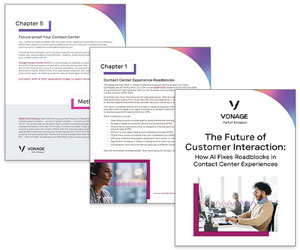Orit Avital shares her keys to successfully managing the implementation of new contact centre processes and procedures.
It is not easy to update contact centre procedures. Often managers will fixate on improving one area of the contact centre, make a change, and move on to the next area that needs development. However, in so quickly changing focus, we forget to manage our first change, meaning that the contact centre doesn’t realise the full benefits of the change, or any benefits at all.
But what can we do about this? With all the firefighting that goes on in the contact centre, it is easy to revert to the basics of our roles and forget the new routines that we have put in place to ensure the success of our new procedures.
We can’t put procedures in place and expect them to manage themselves. Procedures do not replace the manager.
This is why contact centres need a strong and attentive manager. We can’t put procedures in place and expect them to manage themselves. Procedures do not replace the manager.
With this in mind, let’s take a quick look at some of the mistakes that you might be making when implementing new procedures, before taking a look at five practical remedies or best practices.
3 Common Mistakes When Implementing New Procedures
Focus gets easily shifted from one area of development to another, but this isn’t the only reason why contact centre procedure changes are not successful.
Here are three mistakes that many managers also make.
Failing to Get the Team Invested in the New Procedures
Managers often define procedures aiming to develop and promote work processes in the contact centre without consulting their team first. This means that their team is far less likely to buy in to the proposed changes and alter their routines to make the change a success.
Managers often define procedures aiming to develop and promote work processes in the contact centre without consulting their team first. This means that their team is far less likely to buy in to the proposed changes…
It’s vital that advisors understand how the change can benefit the organisation and themselves.
So, listen to their concerns and make sure the team know how this new change will benefit them.
Not Following Up After Roll-Out
Managers will impart many instructions to intermediate management and advisors, expecting them to stick. But there is a lot going on in the contact centre, so if routine follow-ups aren’t in place, these instructions may fall by the wayside over time.
Even if your instructions are clearly defined, a good manager will make the time to follow up their instructions and ensure that the team are well supported in carrying out their new routines.
Not Defining What Success Looks Like
Managers sometimes define in detail what needs to change, but they don’t define what success looks like. There needs to be a measure for the success of your process change – whether that’s decreasing contact volumes, increased satisfaction etc.
What you mean by success needs to be shared with advisors, so there is a target to aim for. Then, if this target is reached, it should be celebrated, so the team become more enthusiastic about future procedure changes.
For some ideas of how to celebrate success in the contact centre, read our article: 10 Fun Ways to Motivate Your Agents
The Result of These Mistakes
Despite making these mistakes, managers often expect a smooth implementation of their new procedure, wanting and demanding to see results – sometimes immediately.
So managers are often left disappointed or, alternatively, they are not surprised, but explain that it was clear to them that it was not implemented as they wanted and defined to begin with.

Despite making these mistakes, managers often expect a smooth implementation of their new procedure, wanting and demanding to see results – sometimes immediately.
Then, the manager rids themselves of this task and moves on to the next thing that attracts their attention. After all, because of the current workflows, they have no choice. A procedure was imposed and it didn’t work out, what is there left to do?
How Can You Prevent This Cycle?
I’m sure that many of you can relate to the scenario above. I see it with my own eyes every day in contact centres. It is logical, and there are probably managers in other fields who find themselves in the same situation.
However, a manager in the contact centre cannot allow this situation to repeat itself. They have the power to positively affect the success of any new procedure; they only need to use this “power” correctly.
Sound promising? Great!
Here are five best practices for contact centre management, which will help you to reduce the number of these “failed” implementation cases and will also enable you to see more benefit in future investments.
5 Tips to Successfully Managing Changes to Contact Centre Procedures
Before getting into the five tips, we must understand that a procedure does not replace a manager. This means that even if you have defined a procedure, your managerial presence in turning these procedures into effective routines is essential.
Setting instructions and making your intentions known is a great place for a manager to start, but without the addition of key preliminary and follow-up actions, you cannot expect to see results.
1. Share Ideas in Brainstorming Sessions
For the best possible engagement, before laying down your new procedures, make sure that you talk to the team. Getting feedback from every level of the contact centre is ideal.
Every different approach and point of view can teach you one more thing about what is about to happen and will help you to guide your plan.
Every different approach and point of view can teach you one more thing about what is about to happen and will help you to guide your plan.
Also, if you can engage with advisors by using these sessions to get an idea of their worries regarding how this process change might impact them, you can avoid these concerns and get them invested in your plans by sharing some of the benefits.
2. Set Clear Expectations
Create routines for all those involved in making the implementation a success, but first ensure that the team are happy with their new routines and that they fit into everyone’s schedules well.
Walk the team through their new routines for the first couple of weeks to ensure that they know what is expected from them.
Walk the team through their new routines for the first couple of weeks to ensure that they know what is expected from them.
Also, set intermediate goals to keep track of your progress. Do not leave this important part to chance. Plan the implementation process in the same depth for all of the relevant levels.
3. Add “Control Junctions” to Your Daily Routine
Don’t pass control on to team leaders and tell them to manage the change only for advisors to tell them that the change isn’t possible. This can put everyone in an awkward position.
As a manager, it is ultimately your responsibility to manage change. So it is important to add “control junctions” into your daily agenda.

Control junctions are short segments of time that you schedule into your day to ensure that procedure changes have been implemented correctly.
Control junctions, which I sometimes call “reality monitoring junctions”, are short segments of time that you schedule into your day, to ensure that procedure changes have been implemented correctly.
Schedule this time to make a commitment and show leadership. If you’re spending time controlling the implementation, your team will know it’s important.
4. Remember That Every Decision Can Be Changed
A procedure is written in a certain reality, but then things change – as there may be unexpected hurdles that you may have to overcome.
Flexibility must be built into the process, so that whatever changes are made to the procedure, it still serves the initial purpose, which is not the implementation but the result.
Flexibility must be built into the process, so that whatever changes are made to the procedure, it still serves the initial purpose, which is not the implementation but the result.
So, coordinate expectations with yourselves and with all of those involved – stressing that there is room for a change in the methods of operation and in the decisions, on the go.
While this does not mean that the procedure isn’t good, it means that it must be adapted to the conditions of reality in order to be excellent!
5. Be a Leader
In order to be a prominent leader, you must first of all be a hands-on manager.
Develop your broad view (vision, objectives, values, etc.) and connect everyone to it in a variety of ways.
Connection to the broad picture will allow the supposedly “little” things to exist in reality, including the procedures which you wish to implement.
For more from Orit on the topic of leadership, read her article: How to Develop Team Leaders in the Contact Centre
In Summary
There are managers who can admit, hand on heart, that during the past year, more ideas, projects and procedures have dissolved than have succeeded in improving the contact centre.
If you summarise the time and resources that you have invested in the development of these procedures that ultimately did not stick, you will discover that a huge amount of potential has been wasted.
However, this does not mean that you give up. Managerial courage is required to lead you to continue developing procedures and routines which will improve the contact centre and, at the same time, develop your managerial skills.
Remember that we are not only marching towards the future – we are creating it!

Orit Avital
Your importance as managers in the promotion of the contact centre cannot be replaced, not even with a whole book of procedures.
I hope these tips – such as creating brainstorming sessions, adding control junctions and building in flexibility – help you to better manage resources and celebrate more successes in the future.
Good luck!
Thanks to Orit Avital at Ottorita for sharing this article with us.
For more from Orit, read some of the following articles:
- 3 Essential Management Routines for a Contact Centre Manager
- How to Support Your Contact Centre Managers to Improve Performance
- Create a Contact Centre Orientation Plan to Reduce Attrition
Author: Orit Avital
Published On: 24th Apr 2019 - Last modified: 18th Aug 2025
Read more about - Customer Service Strategy, Customer Service, Orit Avital, Service Strategy, Team Management



















